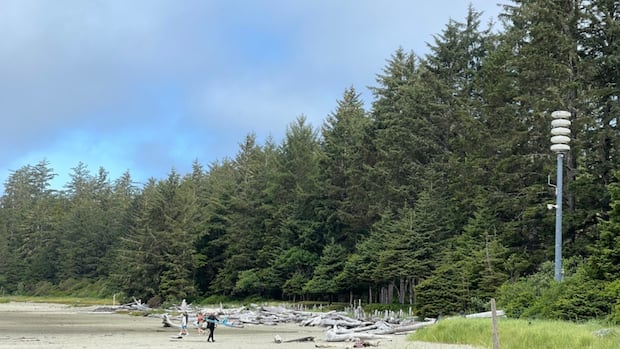Tsunamis: What are they and how do they happen?

On Tuesday, a powerful 8.8 magnitude earthquake rocked the area around Russia's Kamchatka Peninsula, resulting in tsunami warnings being issued around the world. From Hawaii to Japan and the B.C. coast to Chile and Australia, people were warned that high water could inundate their coastlines.
Many people remember the deadly 2004 Boxing Day tsunami, which followed a 9.1 magnitude earthquake off the coast of Sumatra, Indonesia. More than 280,000 people died, and more than one million people were displaced in south Asia and east Africa.
Another memorable and tragic earthquake and tsunami was the Tohoku event in 2011, which forced the shutdown of Japan's Fukushima nuclear power plant and killed more than 15,000 people.
Clearly, tsunamis occur, but how often and how dangerous can they be? Here are a few tsunami facts.

The answer is less simple than some imagine.
Most people tend to think of a tsunami as a single large wave that reaches a coastline. But a tsunami is actually a series of waves, generated by the displacement of water in the ocean. It can raise water levels by centimetres to tens of metres and can wash away homes, buildings and people.
Tsunami waves travel in all directions and can move across an entire ocean basin — as we saw with the Kamchatka earthquake on Tuesday, which travelled all the way from the north Pacific to the south Pacific to as far away as New Zealand.
And they don't just stay at the coastline. They can travel up rivers and bays and can last for several hours or days as they slosh back and forth across an ocean basin.

Katsu Goda, associate professor in Earth sciences at Western University and Canada Research Chair in Multi-Hazard Risk Assessment, explained that it's like if you stuck your finger in a bowl of water, you would see small ripples, not just one single wave.
What causes a tsunami?Eighty per cent of tsunamis are generated by earthquakes, but that's not their only source.
They can be caused by landslides both above and beneath the ocean. Rarely, they can be caused by atmospheric changes. These are called meteotsunamis. In fact, one is believed to have occurred on Lake Superior in June near Thunder Bay, Ont.

Underwater landslides can be triggered by relatively average earthquakes, Goda said. Those submarine landslides can extend for hundreds of kilometres, causing a large displacement of water that loin turn propagates upward to cause a tsunami.
It's also important to understand that while an earthquake has an epicentre, it's actually occurring across a hundred kilometres or more.
When they happen in the ocean, that's a lot of displaced water.
How common are they?Tsunamis — particularly large ones like the Sumatra and Tohoku events — are rare, Goda said.
"We think that those [occur] at least a couple of hundred years to a thousand years … for one location," he said.
According to the Global Historical Tsunami Database, dangerous tsunamis occur roughly twice a year. Larger tsunamis that cause damage or deaths more than 1,000 kilometres away happen roughly twice per decade.
Is Canada at risk?When Tuesday's tsunami warnings were issued, they included much of the B.C. coast.
The province is no stranger to threats of earthquakes or tsunamis. That's because the southwestern part of the province sits above the boundary between the oceanic Juan de Fuca plate and the continental North American plate. The boundary is called the Cascadia Subduction Zone and spans 1,000 kilometres from northern Vancouver Island to northern California.
Earthquakes that occur in the Cascadia Subduction Zone are called megathrust earthquakes, with the rupture zone sitting west of Vancouver Island. This is the source of the potential "big one" for B.C., an earthquake with a magnitude of nine or more.
"The Cascadia Subduction Zone, which is known as 'The Big One', is the one that we should be prepared for," Goda said. "If it happens, then there's some things similar to Tohoku or Sumatra would happen. That's what we expect, like, you know, the 10 to 15-metre or even 20-metre tsunami would happen on the coast."

According to Natural Resources Canada, these earthquakes occur roughly every 200 to 800 years. And if there were to be "the big one," there would only be a 15 to 30 minute gap between the earthquake and the first tsunami waves.
But there's also the east coast.
Though not nearly as active as the Pacific Ocean's "Ring of Fire" — a 40,000-kilometre horseshoe-shaped area known for its seismic activity — there is a fault in the middle of the North Atlantic Ocean.
In fact, there was a 7.4 magnitude earthquake in November 1929 that caused a landslide deep in the ocean, resulting in a tsunami that generated waves three to seven metres in Nova Scotia. In Newfoundland, waves reached 13 metres.
Goda said that while there's no way to stop a tsunami, it is important to have good warning systems in place.
That seemed to be the case with this most recent earthquake and tsunami.
"I think it's very difficult to prevent the wave itself, it's just like — in my opinion — huge energy," he said.
"I think that the only solution is the evacuation to save people's lives. So early warning is important, and the tsunami evacuation training is important, and there should be a place that the people can evacuate to."
cbc.ca





